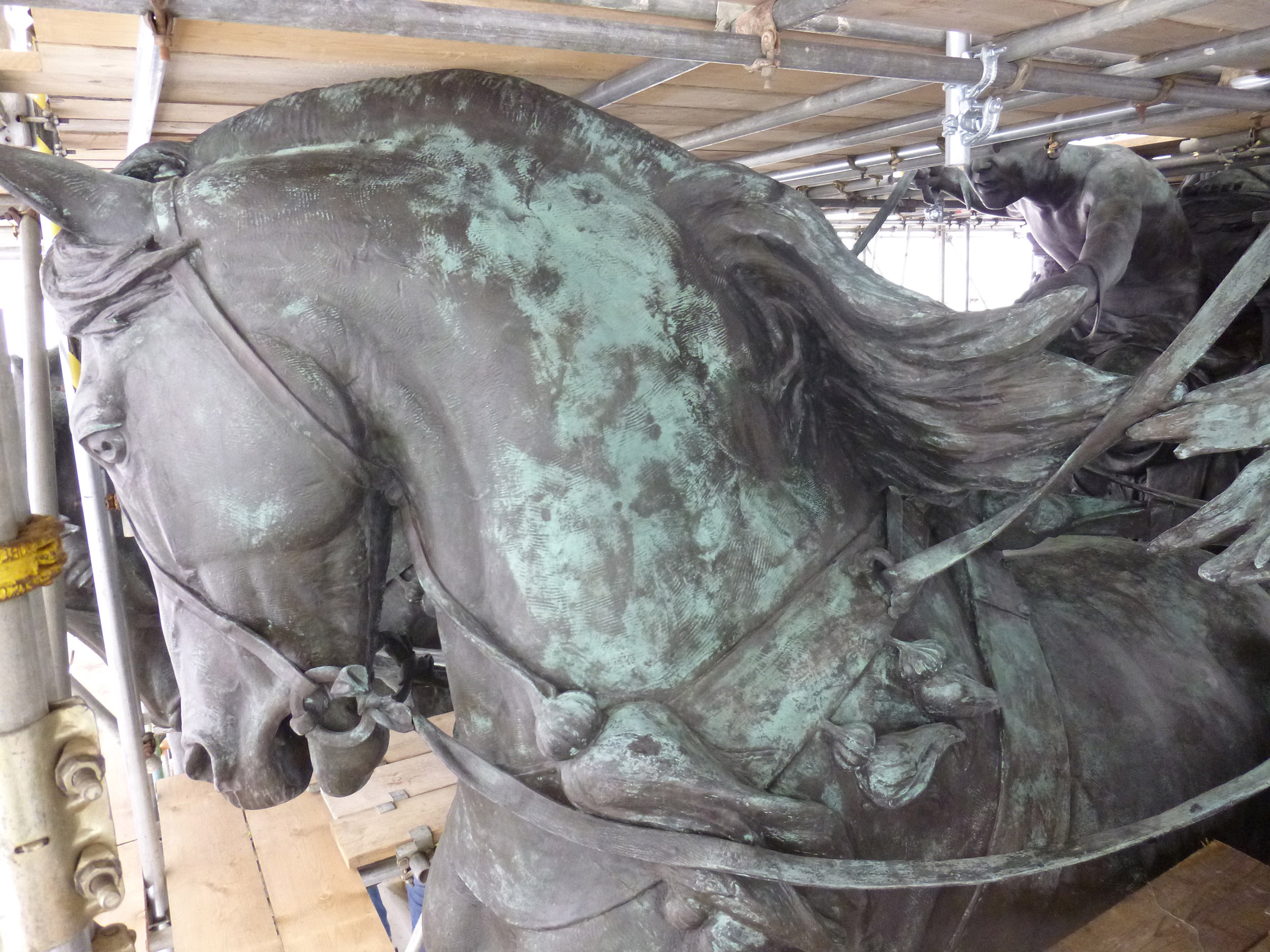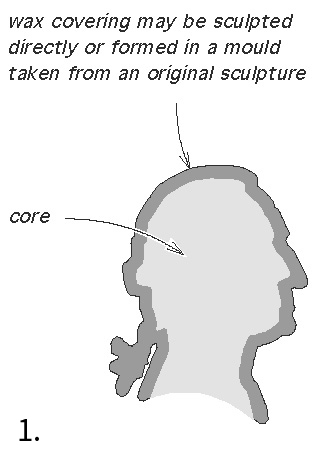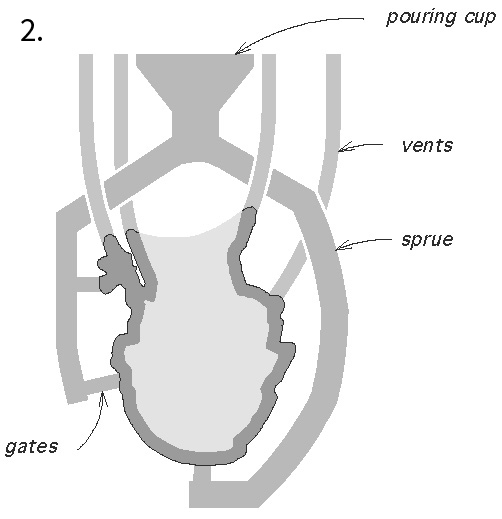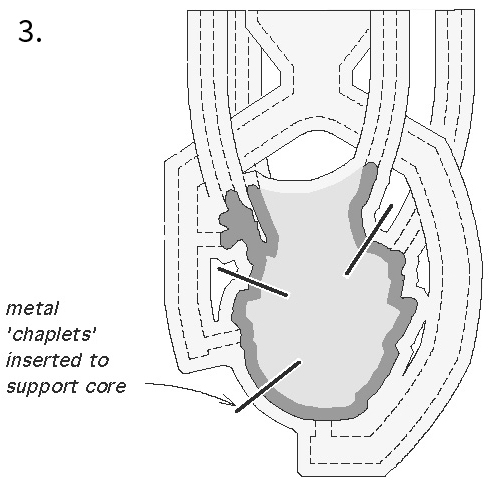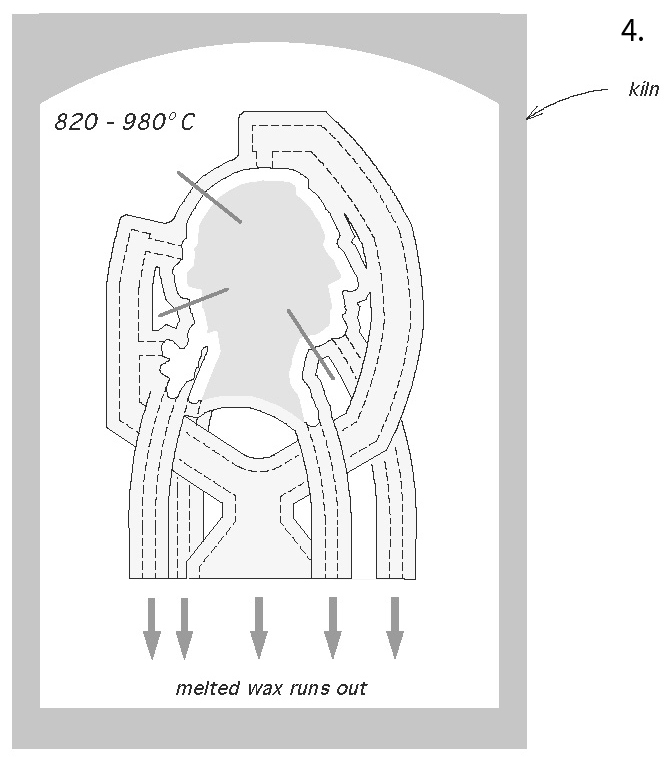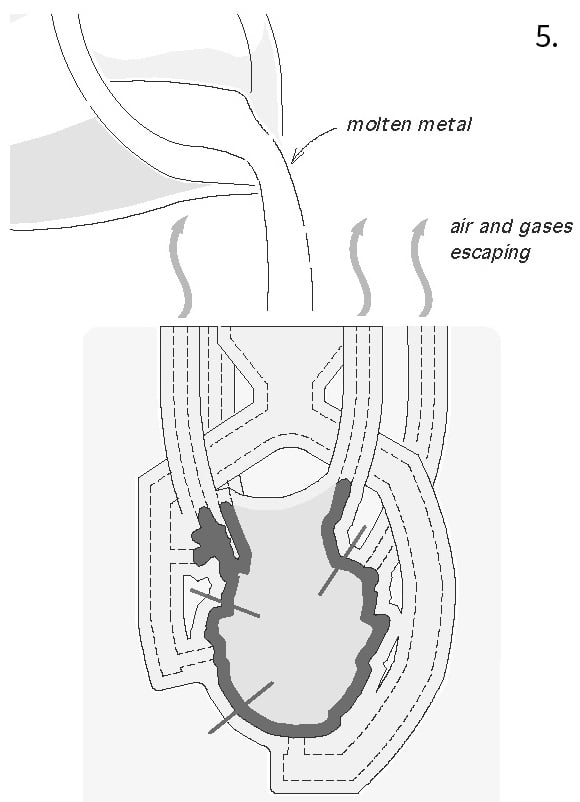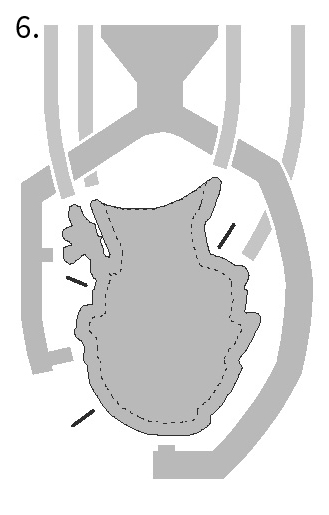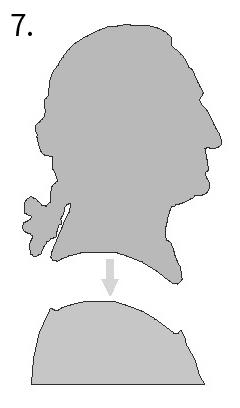Issues Common to all Metal Statuary
Construction methods, problems and treatment techniques common to all metal statuary.
Construction methods
Metal statuary was constructed using various metals and fabrication techniques, but the majority was, and still is, cast from bronze. This was done by specialist sculpture foundries, using either the lost-wax method or sand casting.
Lost-wax casting
Lost-wax casting is the most common method of construction. It allows several identical casts to be made of a sculpture.
Since the Italian Renaissance (15th century), lost-wax casting has followed the ‘indirect method’, in which a mould is taken from the sculptor’s original model, usually made of clay. From the negative mould, a wax copy of the sculpture is produced on a gypsum plaster core. This is then encased in a thick refractory plaster mix and heated to melt away the wax. Next, molten metal is poured into the cavity left within the plaster. Once cool, the plaster casing (or investment) is removed to reveal the sculpture.
Lost-wax casting process
Please click on the gallery images to enlarge.
Sand casting
Sand casting involves a one-off mould, usually a mix of sand and fine clays, pressed around an original sculpture. The sculpture is then removed, and molten metal is poured into the negative impression.
Large statues were cast in many sections, which were joined together by the foundry using sleeved, pinned or riveted joints, known as ‘Roman joints’. This process has now been superseded by welding.
Large statues (such as equestrian bronzes) or lead statues, where the sculpture could not support its own weight, were cast with an internal wrought-iron framework known as an armature. The armature added necessary strength and allowed the sculpture to be secured to a plinth.
Once the statue was assembled, the metal was finished by hand. This involved applying a chemical patina (in the case of bronze) and/or a surface finish, such as a transparent or tinted wax, oil or natural varnish. The surface coating not only enhanced its appearance but also gave some protection from the elements by creating a barrier between the humid air and the metal. This prevented oxidising, corroding or rusting, and maintained the finish as intended by the artist. Sometimes, leaf gilding was used to highlight decorative elements or even to embellish the whole statue.
Maintenance
Use regular maintenance visits to monitor the condition of statues and to undertake simple care procedures. Generally, statues need to be washed annually, with warm water and a gentle biodegradable detergent, to remove dirt and detritus. After cleaning, you may need to retouch or reapply protective coatings. Always use skilled conservators for this kind of work.
Problems and treatment techniques
Loss of surface finishes
Most problems with metal statuary start when the protective surface finish is allowed to degrade or disappear over time.
Poor environments, such as those containing industrial pollutants or salt, combined with a lack of protective coating can cause severe corrosion. This may damage the surface of the sculpture and fine sculptural detail may be lost.
It is never too late to treat a damaged surface and protect it for the future. Always commission a specialist for this kind of work. An inappropriate or poorly applied coating could make the problem worse. Where a protective coating is replaced during conservation, regular maintenance afterwards is very important and will save money in the long run.
Corroded armatures
If water is able to reach the internal iron armature, the framework will rust over time. As the volume of rust increases, the resulting pressure can, in extreme circumstances, split the sculpture. This is called rust jacking. The rusting armature will gradually lose strength and fail. This problem is particularly common with lead sculpture, but can apply to any metal.
It may be necessary for a metalwork conservator to either strengthen a corroded armature or remove and replace it with one made of stainless steel or phosphor bronze. This is a skilled operation, but it is often the only way to ensure a statue’s survival. The conservator may need to cut windows into the sculpture at various points to secure the new armature inside. They would then reassemble the sculpture and repair and finish the surfaces to match the existing ones.
Casting flaws
Casting is a tricky process, and manufacturing flaws are often found. Although the foundry would have repaired any flaws at the time of making, they can be prone to weakness and fracture later. For example, castings may retain remnants of plaster on the inside of the statue, and sometimes this may come through to the surface as white or greyish-green powdery deposits. This indicates that water is entering the casting and may cause corrosion as the plaster remnants act as a water reservoir. Any gypsum residues can attract pollutants, so they should be removed before they build up. Furthermore, surface repairs, patches and blemish fills put in by the foundry may fail and encourage corrosion. It is often enough to clean and fill gaps and water traps to provide protection.
Physical damage
All metal statuary is vulnerable to physical damage caused by the failure of fixings, road traffic accidents, vandalism, attempted theft or storms.
Contact a metals conservator to assess the damage and advise on appropriate remedial options, specific to the type of metal and level of harm.
Inappropriate treatment and repair
Many metal monuments have suffered from poor surface treatments, ranging from unsuitable paints and lacquers to misguided cleaning by inexperienced contractors using acids or abrasives. It may be possible to remove unsuitable coatings and replace them with appropriate ones. Damage from acid or abrasive cleaning may be irreparable or may be lessened visually, depending on the level of harm and the type of metal.
Poorly executed repairs or those made using the wrong materials often become unsightly or fail structurally. These should be removed and rectified in consultation with a metals conservator.
Missing elements
If parts of a statue or monument are stolen or damaged beyond repair, get specialist advice. Any attempts at replacements must be supported by reliable historic records, such as high-quality archive photographs.
Where theft is a potential ongoing problem, consider how to improve the statue's physical security.
Who can help?
Caring for metal statuary – including repairs, cleaning and applying protective surface treatments – requires specialist knowledge. A qualified metalwork conservator (accredited by the Institute of Conservation), with relevant experience working on sculpture, can provide sound practical advice on all aspects of physical repair, maintenance and security.
They may be able to give initial advice using basic information and clear photographs of the areas of damage or concern. After discussion, they may then visit the statue or monument to make a detailed assessment of its condition and the causes of deterioration, and to provide an estimate for any recommended conservation work. The conservator will normally charge for the service at this stage. Find out more about commissioning a conservator.
-
Next: Bronze Statuary
Construction methods, problems and treatment techniques specific to bronze statuary.
-
Previous: Metals in Conservation
Guidance on deterioration and conservation of architectural metalwork and metal statuary.
-
Back: Return to the contents list
Return to the list of pages about looking after metal statuary.

